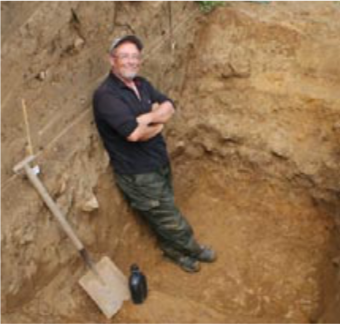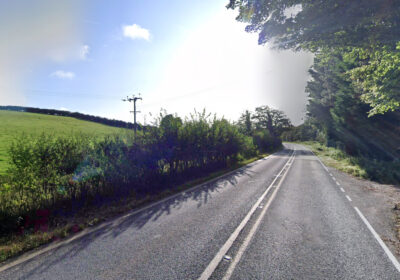Elizabeth’s story of the unearthing of around 22,500 early fourth century Roman coins in a field next to her house had me intrigued. Through a mutual friend I was introduced to Elizabeth because she wanted to know more about the Roman activity in her village of Nether Compton and that is why I was now sitting in her 15th century cottage next to the site of the find. The coins were of Emperor Constantine of around AD 330- 340, of small denomination and in mint condition.
Some years before she had arranged to have a geophysics survey undertaken on the field and the results showed not only regular medieval field systems but also the remains of a large ditched enclosure, one half of which had been unfortunately destroyed by a sunken lane. With the permission of the landowner Dorset Diggers Community Archaeology Group planned to excavate this ditch and hopefully find artefacts which would tell us the date of when it was first dug. Was it connected to the coin hoard?
As we carefully cut a section through the width of the ditch and followed its V-shape into the earth we were pleased to find beautiful black, shiny, decorated pottery called Black Burnished Ware. This is a fairly common pottery found on Roman sites of higher status and made locally in what is now Poole and distributed to other parts of Britain and the Roman Empire. We also found some very fragile plaster and other building materials in the fine, dark soil of the ditch.
Two plaster pieces were particularly intriguing. They were very fine and in strange shapes, suggesting that they were probably created by people rendering their buildings to make them waterproof and able to take paint, which means that there were some well-made dwellings in the immediate area of our site. The metal detecting club, who found the hoard of coins, have also found many pieces of tessera (small, square pieces of stone or clay) that would have been used in mosaics.
What does this tell us? The pottery expert could only give us dates from the Late Iron Age to Early Roman, but with the building materials coming from the same context, even in the same area of the ditch fill, it is highly probable that they have been deposited at the same time.
Thus the pottery would be Early Roman of the first century. The shape of the ditch would also point to it being dug just after the invasion of Britain by the Romans in AD 43. If that is the case, then this site is very important indeed. Not many Roman camps have been dug, although many have been identified.
We now know that the hoard was deposited much later than the ditch. The pot is first century and the hoard early fourth century. It is likely that the ditches were still visible when the hoard was buried and it may be the case that a memory of the enclosure was one reason as to why the hoard was buried here, where Roman soldiers once slept in their tents.
Support Us
Thank you all so, so much for the love and appreciation you’ve shown us since we launched the New Blackmore Vale.
Please show your support and add a review on our Facebook page or on Google.









Leave a Reply